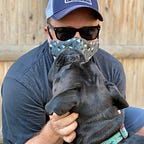Making progress one window at a time
Working to reduce fatal bird collisions with glass
A biologist with the U.S. Fish and Wildlife Service’s Migratory Bird Program, Joelle Gehring is the Service’s lead on reducing bird collisions with buildings. She answered a few questions about how the Service is tackling this problem and what we can do at home.
Q: The Cornell Lab of Ornithology’s “Seven Simple Actions to Help Birds” lists “make windows safer, day and night” as a priority. Why is this so important?
A: Every year, nearly one billion birds collide with glass in the United States. Most collisions occur at buildings four stories or shorter. Birds do not see glass as a barrier and attempt to fly through it, especially if they see vegetation reflections or house plants through the glass.
Fortunately, we have inexpensive and attractive options to make our homes and offices safer for birds. Whether it’s creating visual barriers with parachute cord or tempera paint, using etched or frosted glass, or any of a number of other approaches, reducing bird collisions with glass is important and relatively easy!
In fact, our team has created cut-outs of three at-risk bird species — Cerulean warbler, golden-winged warbler, and wood thrush — you can print out and place on the outside of your windows to try to help. Just remember, the silhouettes need to cover a lot of the glass — as birds may try to fly through any perceived openings.
We chose to highlight songbird species that have striking colors, patterns, and calls, and face threats from more than just windows. These eastern forest birds have lost hardwood forest habitat across their range, leading to dramatic population declines, and all three are on the U.S. Fish and Wildlife Service’s Birds of Conservation Concern list.
The Service is working with partners to restore and manage large areas of hardwood forest with their needs in mind. When you see these cutouts on your window, feel good that you are helping them, too.
Q: What is the Service doing to help reduce bird collisions at its buildings?
A: Scientists estimate that bird populations in North America have decreased by almost three billion birds since 1970. Big losses require big responses.
The Service is addressing the loss of migratory birds from a species group perspective — shorebirds or grassland birds, for example — and a direct fatality perspective. By treating our glass to reduce bird collisions and helping others to do the same we can make a big difference for migratory birds. We are leading by example and sharing our experiences with others so that they can join in making the world safer for birds.
The Great American Outdoors Act is supporting renovations at selected Service buildings, and bird-friendly glass and other measures, such as reduced nighttime lighting, are being incorporated into renovations and new buildings at several sites. Some bird-friendly measures such as reduced nighttime lighting and fritted glass — glass printed with ink that includes tiny particles of ground-up glass — reduce energy costs, creating a win-win.
For staff, the Service is also developing a user-friendly, interactive digital “story map” of all national wildlife refuge and fish hatchery buildings that will include a survey allowing staff to quantify and prioritize which buildings need the most attention for glass treatment to reduce bird collisions. The map will include information on inexpensive methods to treat glass, energy efficient and bird-friendly glass types for remodeling projects, and outreach information for homeowners, office owners, and the public. The Service even has some funding available for Service projects that need a bit of extra support.
Q: Are we seeing positive results from efforts to reduce bird collisions?
A: Yes. In the Service’s North Atlantic-Appalachian Region, for example, staffers at several national wildlife refuge buildings have already treated their building glass or made other changes to reduce bird collisions, and we’re seeing positive results. In one highlight, work at Chincoteague and Patuxent refuges has significantly reduced bird collisions.
We’re also are seeing increased interest and action at a broad scale as a result of ongoing education efforts by several agencies and organizations. In 2020, former first lady Laura Bush released multiple bird-collision related public service announcements through the George W. Bush Presidential Center. The Department of the Interior’s appropriations bill includes direction to reduce bird collisions at our federal buildings, and the Bird Safe Buildings Act, has continued support in the House and Senate. We are making progress one window at a time.
Q: How can I learn more about reducing bird collisions at my home or workplace?
A: Visit our website! Those interested can also reach out to me anytime and I can provide the information they need. Many will find the glass treatment options easy and inexpensive and some even reduce energy costs. Protecting migratory birds is rewarding! Joelle_Gehring@fws.gov
Learn more about Cornell Lab of Ornithology’s “Seven Simple Actions to Help Birds” on their website
